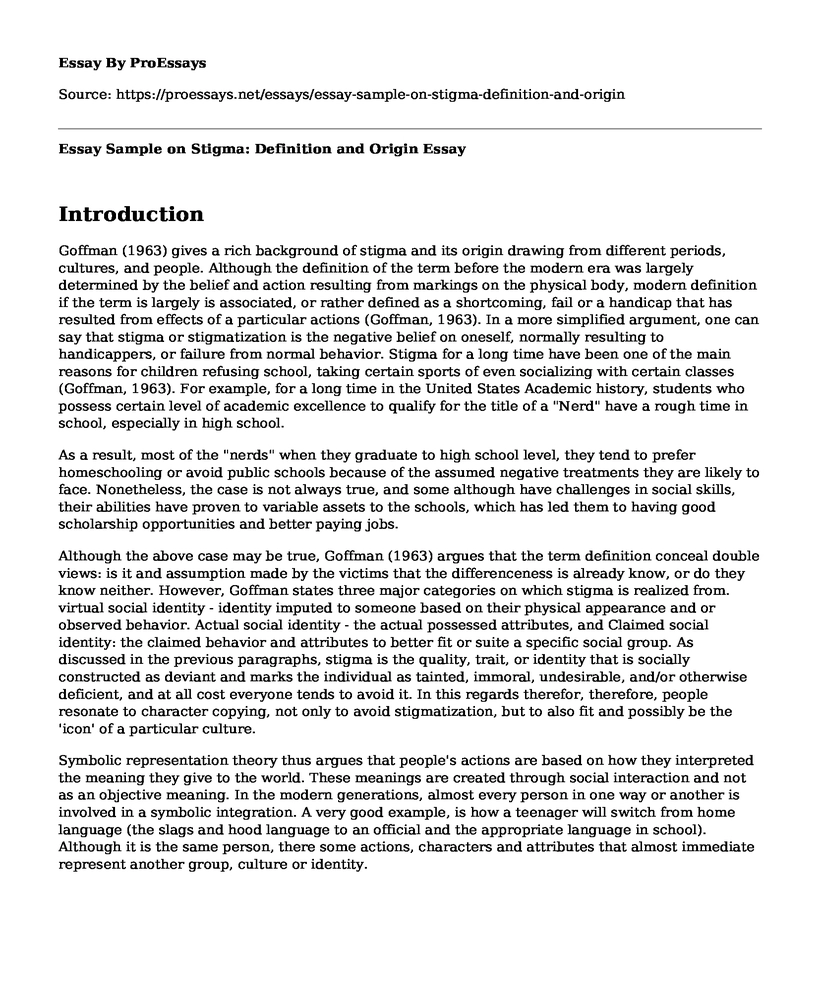Introduction
Goffman (1963) gives a rich background of stigma and its origin drawing from different periods, cultures, and people. Although the definition of the term before the modern era was largely determined by the belief and action resulting from markings on the physical body, modern definition if the term is largely is associated, or rather defined as a shortcoming, fail or a handicap that has resulted from effects of a particular actions (Goffman, 1963). In a more simplified argument, one can say that stigma or stigmatization is the negative belief on oneself, normally resulting to handicappers, or failure from normal behavior. Stigma for a long time have been one of the main reasons for children refusing school, taking certain sports of even socializing with certain classes (Goffman, 1963). For example, for a long time in the United States Academic history, students who possess certain level of academic excellence to qualify for the title of a "Nerd" have a rough time in school, especially in high school.
As a result, most of the "nerds" when they graduate to high school level, they tend to prefer homeschooling or avoid public schools because of the assumed negative treatments they are likely to face. Nonetheless, the case is not always true, and some although have challenges in social skills, their abilities have proven to variable assets to the schools, which has led them to having good scholarship opportunities and better paying jobs.
Although the above case may be true, Goffman (1963) argues that the term definition conceal double views: is it and assumption made by the victims that the differenceness is already know, or do they know neither. However, Goffman states three major categories on which stigma is realized from. virtual social identity - identity imputed to someone based on their physical appearance and or observed behavior. Actual social identity - the actual possessed attributes, and Claimed social identity: the claimed behavior and attributes to better fit or suite a specific social group. As discussed in the previous paragraphs, stigma is the quality, trait, or identity that is socially constructed as deviant and marks the individual as tainted, immoral, undesirable, and/or otherwise deficient, and at all cost everyone tends to avoid it. In this regards therefor, therefore, people resonate to character copying, not only to avoid stigmatization, but to also fit and possibly be the 'icon' of a particular culture.
Symbolic representation theory thus argues that people's actions are based on how they interpreted the meaning they give to the world. These meanings are created through social interaction and not as an objective meaning. In the modern generations, almost every person in one way or another is involved in a symbolic integration. A very good example, is how a teenager will switch from home language (the slags and hood language to an official and the appropriate language in school). Although it is the same person, there some actions, characters and attributes that almost immediate represent another group, culture or identity.
Conclusion
With all the above said, stigma or stigmatization is still a challenge to many. Recent discussions on body shaming, anti-bullying campaigns, and the counselling programs within learning institutions are the first steps to addressing this social problem. However, adults and teachers, especially, have a huge role to play, not only in helping the young generation be comfortable and identify themselves with the right identities, but also help those who feel stigmatized for their appearance appreciate their differences and be proud of them.
References
Goffman, E. (1963). Stigma and social identity. In Stigma; Notes on the Management of Spoiled Identity. Englewood Cliffs, NJ: Prentice-Hall.
Goffman, E. (1963). Stigma and social identity. In Stigma; Notes on the Management of Spoiled Identity. Englewood Cliffs, NJ: Prentice-Hall.
Cite this page
Essay Sample on Stigma: Definition and Origin. (2023, Jan 30). Retrieved from https://proessays.net/essays/essay-sample-on-stigma-definition-and-origin
If you are the original author of this essay and no longer wish to have it published on the ProEssays website, please click below to request its removal:
- Case Study on Domestic Violence: Chloe's Case Scenario
- Freedom Is a Natural Condition of a Person - Essay Sample
- Risk Behaviors in Sexually Abused Adolescents Diagnosed With Post-Traumatic Stress Disorder and Depression
- Essay Example on Joe the King: 14-Year-Old Struggling in Abusive Family
- Essay Sample on El Chapo: Exploring Social Class in a Diverse Way
- Olmec Mask: A Mesoamerican Jade Artwork - Essay Sample
- Crisis Comm: Traditional Models, Social Media, & Current Challenges - Essay Sample







